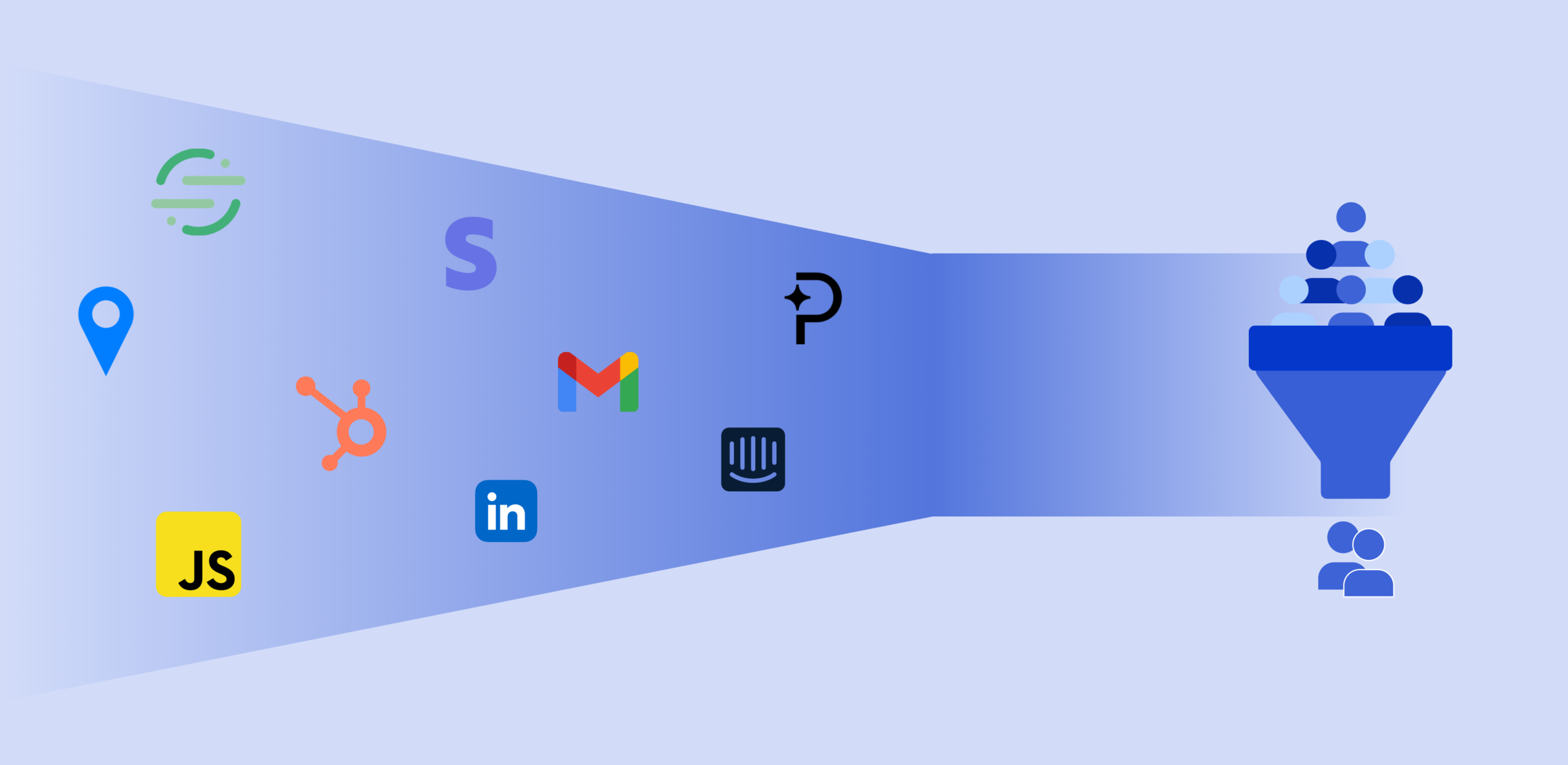The term PQL, or Product Qualified Lead, might sound like just another marketing jargon, but it holds significant value in the sales funnel. But what exactly is a PQL and how do you define it? Let’s dive deeper into understanding this important concept.
If you’ve ever wondered how some big SaaS companies (Slack, HubSpot, and more…) converting users, the secret might just lie in their understanding of product-qualified leads.
What is Product Qualified Lead?
PQL, or Product Qualified Lead, is another type of lead that is crucial in the sales funnel. Basically Product-Qualified Lead is a lead type that is lead qualification process is based on both product usage data and user engagement.
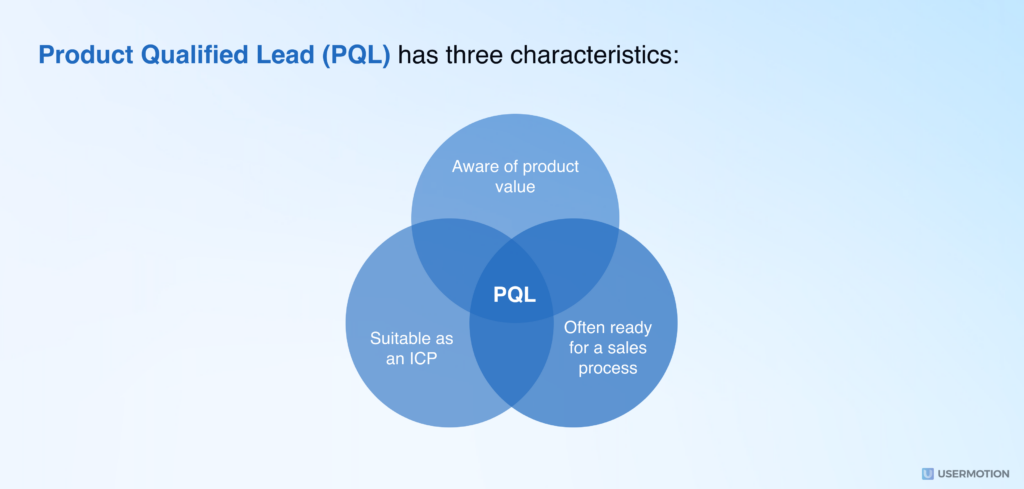
It usually comes with the free trials or freemium pricing models, but PQLs represent a deeper engagement, often marked by:
- Alignment with the Ideal Customer Profile (ICP).
- Significant user engagement.
- Strong indicators of purchase intent.
In SaaS context, it’s a lead that derives value from your product, fits into your ideal customer profile and shows high buying intent.
PQLs like all other lead types are not a customer yet, but has a strong likelihood to be a customer comparing to the other lead types. They are more valuable than other lead types (like MQLs) who has never interacted and saw the value of the product.
PQLs typically exist in the middle to lower end of the sales funnel. They are past the initial awareness phase and are now in the consideration and decision phases, as they have experienced your product at firsthand. This means, that when you pitch to a PQL, you’re not trying to introduce them to the value of your product – they already get it.
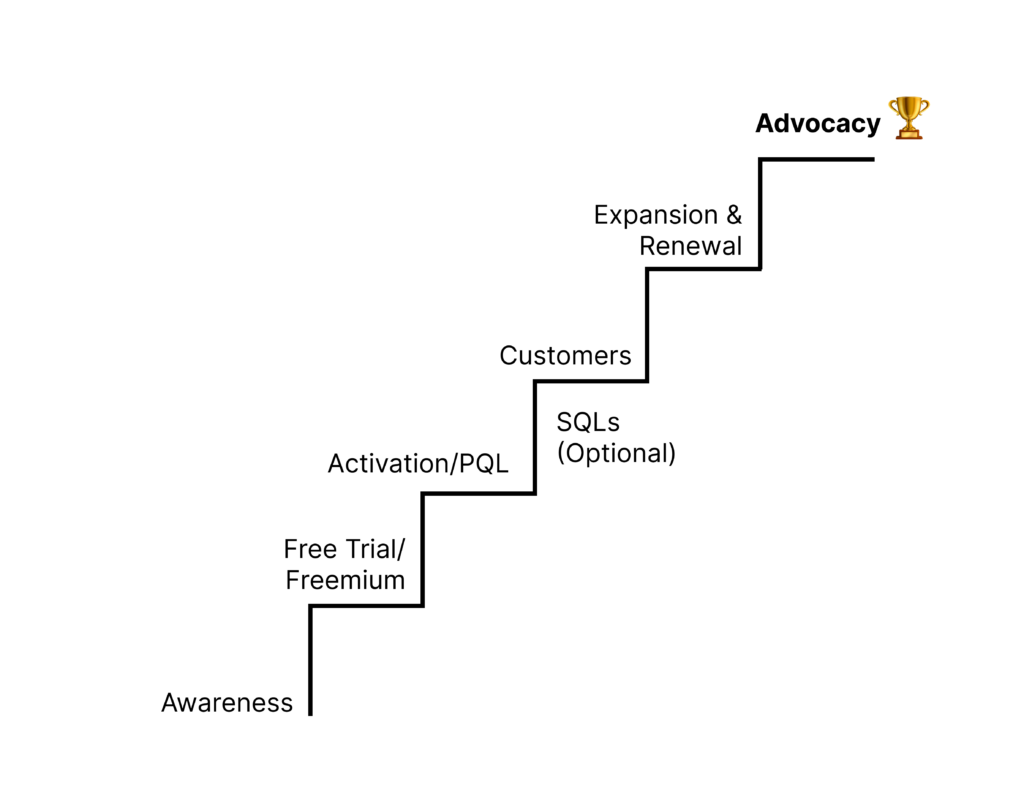
PQL Examples;
Spotify Example: An example of a PQL could be a user of the Spotify freemium model who has frequently interacted with the platform, listened to a significant number of songs, and created several playlists. This active usage and engagement with the product shows that the user finds value in Spotify’s offering, making them a strong candidate for conversion from freemium users to a premium, paying customer.
HubSpot Example: Another example of PQL can be a user who has signed up for a free trial of HubSpot. Consistent usage of the software, such as creating and tracking email campaigns or utilizing the CRM, demonstrates that they find value in what HubSpot is offering. This makes them highly likely to convert into a paying customer after the trial period.
What is NOT a Product-Qualified Lead?
It’s equally vital to understand what doesn’t qualify someone as a product-qualified lead (PQL) as it is to define what does. Let’s clarify what PQLs aren’t:
- They aren’t just users who upgrade from a free plan.
Simply because a user transitions from a free to a paid plan doesn’t automatically classify them as a PQL. It’s essential to dive deeper into their engagement and usage patterns. - Only signing up for a free trial doesn’t make someone a PQL.
It’s a mistake to assume that just signing up for a free trial elevates a user to PQL status. The true measure lies in their engagement and how they use the product during the trial period. - Defining a PQL based on superficial actions;
Like just signing up can skew your team’s objectives and potentially hinder your product’s growth. The goal should always be to help users derive genuine value from what you offer. - They’re distinct from Marketing Qualified Leads and Sales Qualified Leads.
While both MQLs and SQLs indicate a user’s interest and potential to convert, their qualification processes and criteria differ. MQLs are typically measured by marketing engagement such as downloads, webpage visits, or webinar attendance, while PQLs center around product engagement and usage.
Marketing Qualified Leads (MQLs)
The distinction is somewhat straightforward. While MQLs might have had tangential interactions with your product – subscribing to newsletters, downloading resources, etc. – PQLs have deeper, more intimate experiences.
This typically translates to an actual product usage experience, which is inherently more valuable than an MQL’s surface-level engagement.
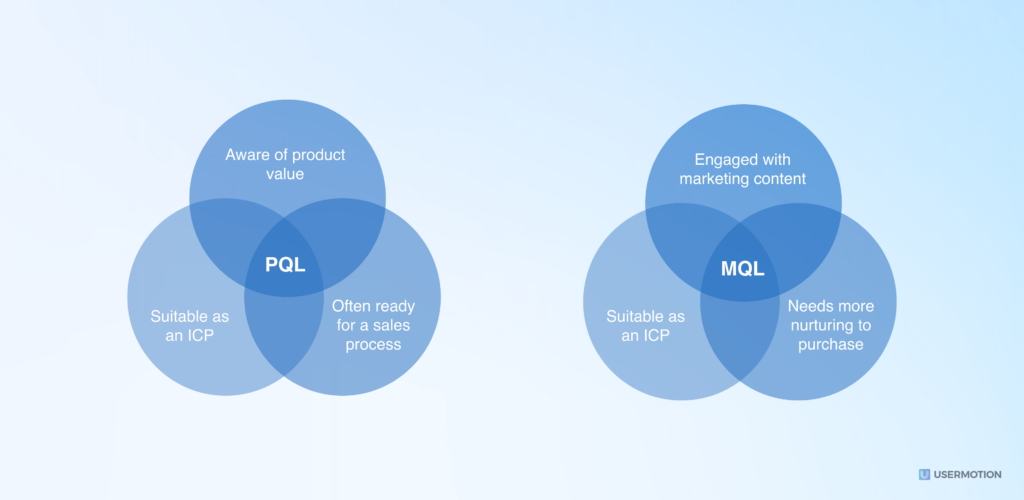
Both leads are valuable. The difference between them is that PQLs have experienced the product, while MQLs have interacted with some external items related to the product.
Sales Qualified Leads (SQLs)
Sales-Qualified Leads are leads that the sales team has accepted as worthy of a direct sales follow-up. They have been vetted and qualified by both the marketing and sales teams, and are considered ready for the next step in the sales process.
In essence, while both PQLs and SQLs are leads that have shown interest in your product or service, PQLs have demonstrated this through their interaction with the product, while SQLs have been identified as ready for a sales approach based on a set of qualifying criteria.
Why are Product-Qualified Leads Important?
Why should you care about PQLs? Why is it important to focus on them? These are valid questions, and the answers lie in the unique nature of PQLs and the pivotal role they play in the sales process.
When these creative approaches lead to real results, word spreads quickly. As proof of this, let’s look at some of the real benefits of using PQLs:
1. Shorter Sales Cycles
Time is money! We all love shortcuts, right? If you have a shorter route to reach your destination, you will use that and reach it in less time.
PQLs have a similar meaning for sales teams. By focusing only on relevant leads, SaaS sales teams can convert high-probability leads into paying customers. Thus, while reaching large sales figures in a short time, they do not waste time with irrelevant customer candidates.
The sales cycle of PQLs can be faster than other types of leads because they have already demonstrated a strong interest in and fit for the product.
User and account demographics, usage, frequency, engagement, and support metrics along with several other useful data can be gathered by using PQL as a main sales effort. As you can see above, PQL has a shorter sales process than traditional ones and is more productive.
2. Higher Conversion Rates
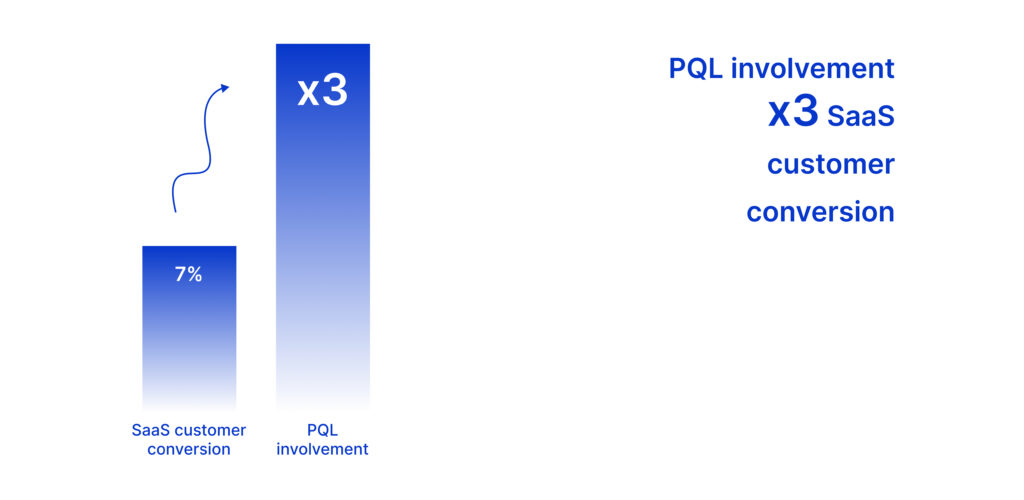
Unlike other types of leads, PQLs have already demonstrated a clear interest in your product by actively using it. Their interaction with your product indicates that they find value in what you’re offering, making them highly likely to convert into a paying customer.
A fact: PQLs convert up to 2x more than other leads. Why? They’re genuinely interested. So, focusing on them boosts sales.
Because they have already shown some interest in the product, product-qualified leads are more likely to turn into paying customers than regular leads.
By targeting leads that are more likely to make a purchase, businesses can increase their conversion rates and generate more revenue.
3. Lower Customer Acquisition Cost
One of the significant benefits of Product Qualified Leads (PQLs) is the lower Customer Acquisition Cost (CAC).
PQLs have already interacted with the product, usually through a free trial or freemium model, and found value in it, they are more likely to convert into paying customers.
This prior interaction reduces the need for extensive marketing and sales efforts, thereby significantly lowering the cost of acquiring these customers. Therefore, focusing on PQLs can be a cost-effective strategy for businesses looking to optimize their sales and marketing budget.
4. Increased Customer Satisfaction
By focusing on product-qualified leads, SaaS companies can better understand their customer’s needs and provide them with the perfect solutions because these potential customers are your product’s target audience. Traditional leads won’t be able to provide you with useful insights, perhaps because they don’t need your product.
PQLs give businesses information that can help them keep customers and increase their lifetime value. With this feedback, you can increase the rate at which your customers are satisfied.
Moreover, PQLs can provide valuable feedback on your product. Since they have used your product, they can provide insights into what’s working well, what’s not, and what can be improved. This feedback can be instrumental in refining your product and enhancing the user experience.
Building a PQL Qualification Process: A Step-by-Step Guide
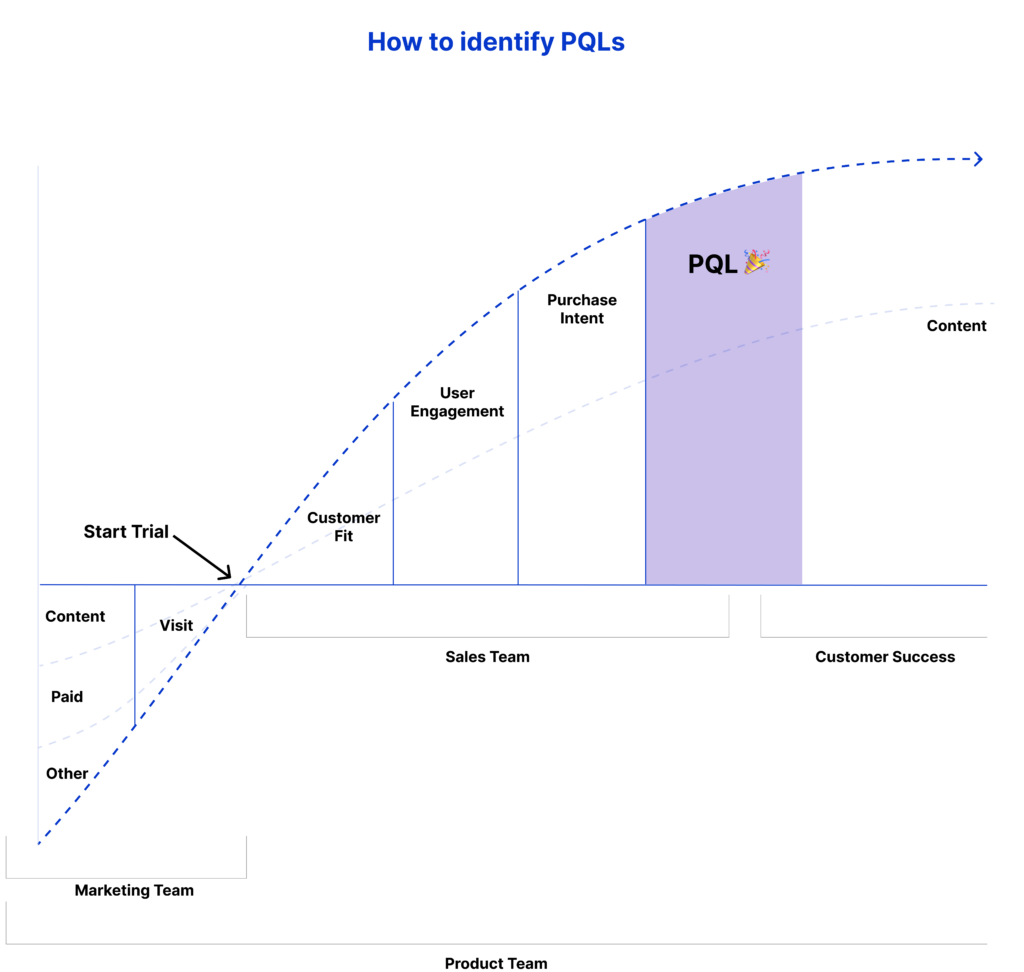
If you want your strategy to work, you must first identify and keep track of your valuable leads. Otherwise, we cannot talk about a strategy. So how do we manage this?
We discussed how to identify product-qualified leads in detail before, but here are some scenarios and some possibilities that will be our primary methods of identifying and tracking PQLs.
1. Define Your Product Activation Points, or Key Events
To start building a PQL qualification process, the first step is to define your product activation events, also known as key events. These are specific actions that users take within your product that indicate they have found value in it and are likely to become paying customers.
Usually these key events are also used in your product on boarding. So if you already have a product on-boarding section in your product, you just basically use that steps as a product activation events.
2. Track All User Engagement Events
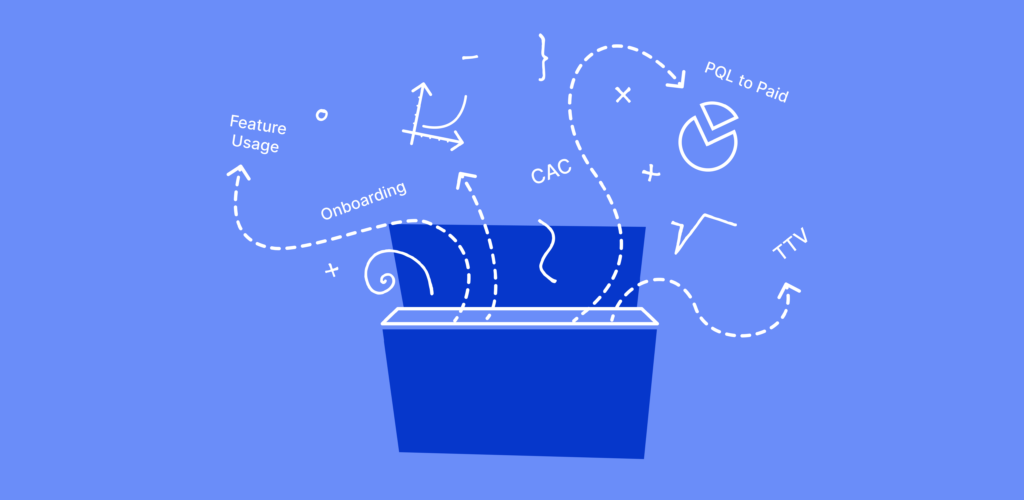
The second step in the process is to track all user engagement events. This includes every interaction that users have with your product, not just the key events. By monitoring all user engagement events, you can gain a comprehensive understanding of how users are interacting with your product, and behavioral data which aids in identifying potential PQLs.
Some of important user engagement events could be;
- Introducing teammates in the account
- Scheduling a product demo
- Implementing integration
- Reading documentation
- Talking to support
3. Assign a Score to Specific Events
The third step involves assigning scores to specific events. This process, known as lead scoring, assists in prioritizing leads that are most likely to convert into customers. As importance of the events are not the equal for all events, it’s important to give a score from the most important to the least imporatant events. The scores can be based on the nature of the event, frequency of occurrence, and other relevant factors.
For example; inviting a teammate in the product would have a more importance than just visiting a documentation page.
5. Identify Your Ideal Customer Profile (ICP) and Buyer Persona
As a bonus step, you should identify your Ideal Customer Profile (ICP) and buyer persona, and make an ICP match. The ICP represents the type of company that would derive the most value from your product and is therefore most likely to convert.
The buyer persona, on the other hand, represents the ideal customer based on market research and real data about your existing customers. By identifying your ICP and buyer persona, you can better target and nurture your PQLs.
By following these actions, you can start to identify PQLs with high intent to purchase.
Best Practices for Managing PQLs
Understanding the nuances of Product-qualified leads (PQLs) is only half the battle.
Effective management of these leads is the key to unlocking their potential and ensuring they translate into valuable conversions for your SaaS business. Here are best practices underscored by data-driven insights to guide you:
1. Transitioning from tracking to action
While identifying and tracking PQLs is essential, the heart lies in your subsequent actions. Many product teams fall short here. It’s not merely about tracking; it’s about strategically ushering these leads toward a purchase decision.
Though it’s a digital journey, at its core, it’s about human-to-human connection. Always ensure your communication feels personalized.
- According to a study by Accenture, 91% of consumers are more likely to purchase from brands that recognize, remember, and provide relevant offers and recommendations.
Offer value through webinars, tutorials, and informative content.
- A HubSpot report revealed that 70% of consumers feel closer to a company as a result of content marketing.
Automation tools can detect when a PQL takes a significant action, like using an advanced feature of your product. This can be a great time to reach out with an offer or incentive.
Not every PQL will convert immediately. By understanding their hesitations, you can refine your approach and product offerings.
Example of transitioning from tracking to action
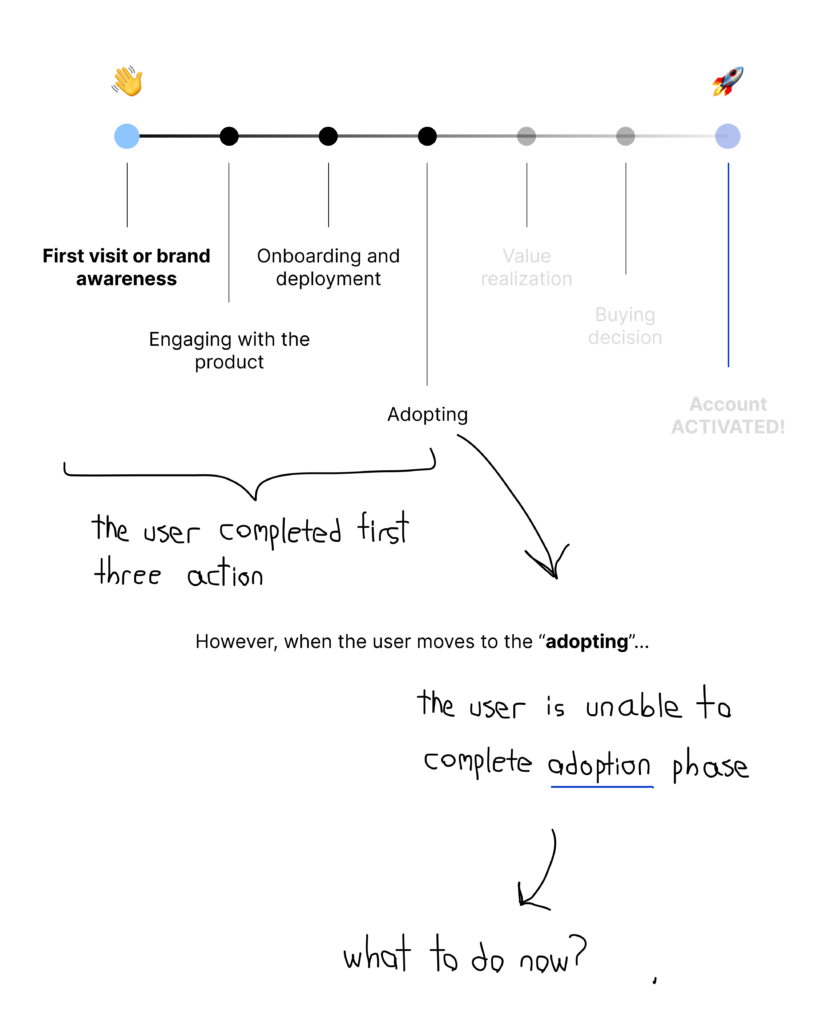
A user starts the journey and completes the first three steps;
- Engagement: The user signs up for the product, watches the introductory video on product features, sets up her user profile, and integrates their email accounts.
- Onboarding: The user starts to explore the features further by setting up a few deals and opportunities, playing around with the dashboard, and even inviting a couple of team members to collaborate.
- Deployment: As her team members start to use the product, the user sets up the main service of the product.
However, when the user moves to;
- Adoption: The user finds it challenging to integrate the tool.
What to do now?
- Ask “Why?”: Directly ask the user if there is any problem because you realize that the user is not going further down in the funnel.
- Detection: You can use tools to detect frequent failures in action.
- Personalized Outreach: Now it’s the moment to reach out to users personally to address and solve their challenges.
- Valuable Content: It’s beneficial to share materials that can help them in overcoming their adoption obstacles.
- Offering Incentives: To make her transition smoother, you can offer the user an extended free trial period and direct access to a technical specialist for a month, ensuring her team can make the most of the platform without hurdles.
Remember, while data drives our decisions, it’s the relationships and value we provide that ultimately influence outcomes. The journey from tracking to taking action should be seamless, personalized, and always grounded in delivering value.
2. Data-driven decision making
When considering product-qualified leads, it’s crucial that every judgment, every nuance, be underpinned by solid data.
A careful observation of user behavior can unfold tons of insights. There are often patterns in these behaviors that signify a deeper product engagement. For instance, it’s not uncommon to find that a user engaging with certain advanced features or spending an extended amount of time on tutorials demonstrates a more pronounced intent to commit and convert.
- A study by McKinsey found that companies that make data-driven decisions are 23 times more likely to acquire customers, 6 times as likely to retain those customers, and 19 times as likely to be profitable as a result.
It’s not just about distinguishing these patterns but also about reacting to them in real-time.
A user who consistently demonstrates high levels of product engagement could be encouraged gently towards a premium offering, using personalized communication.
On the flip side, understanding pain points or areas of friction through data can lead to timely interventions, turning a potentially lost customer into a loyal advocate.
As we navigate the pathways of lead management, let data be the lighthouse guiding our decisions. It ensures that our strategies aren’t just effective, but also resilient and adaptive in an ever-evolving marketplace.
3. Adjusting PQL criteria
Businesses need to define and improve their product qualified lead (PQL) criteria, just like marketers have had to make their campaigns and strategies more flexible.
Users change the way they act. New industry standards are made. Technology changes. The competition gets tougher. In this kind of situation, static definitions of PQLs could become out of date.
Peter Drucker, a management consultant once said, “What gets measured gets better.” But it’s also true that we need to look at how we measure every so often. Using old metrics or criteria is like using an old map to get around: it won’t show you new roads or obstacles.
So, the criteria for PQLs need to be dynamic, keeping pace with the changing tides of user behavior, technology, and market demands. By regularly reassessing and recalibrating, businesses not only stay relevant but also ensure they’re always engaging with the most promising leads.
4. Constant monitoring and adjustment of the product-qualified lead
In order to effectively manage leads for the product, you must constantly control the process and be ready to make changes in light of the data. The criteria you set for your potential users may change over time because current conditions may change, or you may have made a mistake in the past.
This could mean making changes to the system for generating leads, improving the criteria for users, or changing the way leads are generated. By controlling the steps, and making changes as needed, SaaS companies can effectively target the right leads, bringing their conversion rates to great levels.
Final Thoughts
Product-qualified leads have become highly valuable, especially in the post-pandemic, deteriorating economic environment. When companies sell, they want to focus on candidates who are most likely to return. This means a great saving in terms of resources and time.
By putting the quality of leads ahead of the number of leads, businesses can save time and money while also increasing conversion rates and revenue.
Companies can learn a lot about their customer’s behavior and need by looking at how they use their products. This lets them make more targeted and effective marketing campaigns. This is why it’s important for businesses to track and analyze product-qualified leads if they want to improve their sales funnel and grow in today’s highly competitive market.

